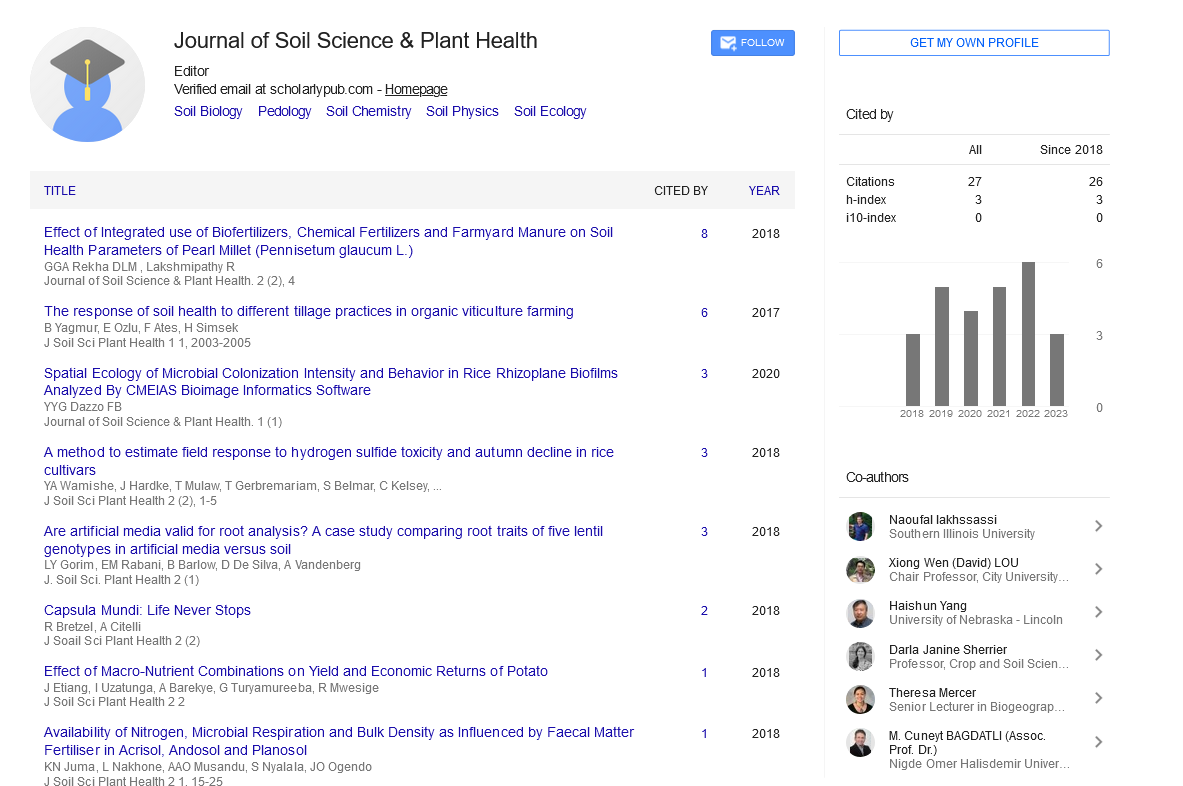Commentary, J Soil Sci Plant Health Vol: 6 Issue: 1
Heavy Applications of Potassium in Fertilizers Can Even Produce Magnesium Deficiency
Kirthana Singh*
Department of Agricultural, Technical University of Denmark, Kongens Lyngby, Denmark
*Corresponding Author: Kirthana Singh
Department of Agricultural, Technical University of Denmark, Kongens Lyngby, Denmark
E-mail:kirthana@gmail.com
Received date: 01 January, 2022, Manuscript No. JSPH-22-59073;
Editor assigned date: 03 January, 2022, PreQC No. JSPH-22-59073 (PQ);
Reviewed date: 17 January, 2022, QC No JSPH-22-59073;
Revised date: 26 January, 2022, Manuscript No. JSPH-22-59073 (R);
Published date: 31 January, 2022, DOI:10.4172/jsph.1000124
Citation: Singh K (2022) Heavy Applications of Potassium in Fertilizers Can Even Produce Magnesium Deficiency. J Soil Sci Plant Health 6:1.
Keywords: Nitrogen, Phosphorus, Lime, gypsum, dolomite, Potassium
Introduction
Soil may be a major source of nutrients needed by plants for growth. The three main nutrients are nitrogen (N), phosphorus (P) and potassium (K). Together they create up the trio referred to as NPK. Other important nutrients are calcium, magnesium and sulphur. Plants also need small quantities of iron, manganese, zinc, copper, boron and molybdenum, referred to as trace elements because only traces are needed by the plant. The role these nutrients play in plant growth is complex, and this document provides only a quick outline. Nitrogen could be a key element in plant growth. It's found all told plant cells, in plant proteins and hormones, and in chlorophyll. Atmospheric nitrogen may be a source of soil nitrogen. Some plants like legumes fix atmospheric nitrogen in their roots; otherwise fertiliser factories use nitrogen from the air to create ammonium sulphate, nitrate and urea. When applied to soil, nitrogen is converted to mineral form, nitrate, so plants can take it up. Soils high in organic matter like chocolate soils are generally higher in nitrogen than podzolic soils. Nitrate is well leached out of soil by heavy rain, leading to soil acidification. Use nitrogen in small amounts often so plants use all of it, or in organic form like composted manure, so leaching is reduced. Phosphorus helps transfer energy from sunlight to plants, stimulates early root and plant growth, and hastens maturity. Very few Australian soils have enough phosphorus for sustained crop and pasture production and therefore the North Coast is not any exception. The foremost common phosphorus source on the North Coast is superphosphate, made up of rock phosphate and acid. All manures contain phosphorus; manure from grain-fed animals may be a particularly rich source. Potassium increases vigour and disease resistance of plants, helps form and move starches, sugars and oils in plants, and might improve fruit quality. Potassium is low or deficient on many of the sandier soils of the North Coast. Also, heavy potassium removal can occur on soils used for intensive grazing and intensive horticultural crops (such as bananas and custard apples). Calcium is important for root health, growth of recent roots and root hairs, and also the development of leaves. It's generally in brief supply within the North Coast's acid soils. Lime, gypsum, dolomite and superphosphate (a mixture of orthophosphate and calcium sulphate) all supply calcium. Lime is that the cheapest and most fitted option for the North Coast; dolomite is beneficial for magnesium and calcium deficiencies, but if used over an extended period will unbalance the calcium/magnesium ratio. Superphosphate is beneficial where calcium and phosphorus are needed.
Intensive Horticulture
Magnesium could be a key component of chlorophyll, the green colour of plants, and is important for photosynthesis (the conversion of the sun's energy to food for the plant). Deficiencies occur mainly on sandy acid soils in high rainfall areas, especially if used for intensive horticulture or dairying. Heavy applications of potassium in fertilisers can even produce magnesium deficiency, so banana growers have to watch magnesium levels because bananas are big potassium users. Sulphur may be a constituent of amino acids in plant proteins and is involved in energy- producing processes in plants. It's chargeable for many flavour and odour compounds in plants like the aroma of onions and cabbage. Sulphur deficiency isn't an issue in soils high in organic matter, but it leaches easily. On the North Coast Sea spray could be a major source of atmospheric sulphur. Superphosphate, gypsum, elemental sulphur and sulphate of ammonia are the most fertiliser sources. Plants require minerals to grow leaves, stems, and roots. Proper nutrition is crucial for seed, flower, and fruit production. Plants also need minerals to supply chlorophyll and do photosynthesis, the method by which they convert sunlight into usable energy. Vitamins and minerals are absolutely necessary for water absorption and circulation. Plants even need these nutrients to facilitate nutrient uptake. The proper balance of vitamins and minerals for plants is crucial for growth, reproduction, and general survival, so this is often something you'll have to listen to as a houseplant owner. During this article, we'll review the explanations why vitamins and minerals are so crucial, which vitamins and minerals your plants will need, and the way you'll supplement these vitamins and minerals to stay your plants as healthy as possible. In nature, organic plant and material break down into the soil, which makes it rich in nutrients and provides a gentle supply of vitamins and minerals that plants can absorb as they grow. Potted plants depend on the nutrients present in their potting soil. This isn't plenty of soil to draw from, and a plant can easily assign the nutrients in its pot within some months. Since organic material isn't constantly breaking down, it's important to feature nutrients to potting soil. In potting mix, nutrients can come from materials like worm castings, compost, guano, fish meal, manure, etc. Pellet or liquid fertilizers are important for keeping nutrient content high and providing plants with a gradual supply of vitamins and minerals. It's also an honest idea to repot your plants every once in an exceedingly while so your plant has access to fresh, nutrient-rich soil per annum just about.
 Spanish
Spanish  Chinese
Chinese  Russian
Russian  German
German  French
French  Japanese
Japanese  Portuguese
Portuguese  Hindi
Hindi 